Feeding your Labrador is easy
You’ve got yourself a Labrador and among things like getting him a good bed and toys, you also have to plan for his food. Feeding your labrador isn’t as straightforward as you might think. But it’s not challenging either. It needs a little planning and a bit of study. While each dog will have his own needs and eating behavior, as a pet parent, you need to ensure that you feed your dog a diet rich in fat and protein, and low in carbohydrates. This article will help you choose the right diet and also offer you tips on how to feed your fur baby.
What’s the best dog food for a Labrador?
The best food for any dog is one that keeps him healthy, without it eating through your pocket at the same time. You need to ensure your dog gets a ‘balanced diet’. But what constitutes a balanced diet? Opinions on this differ and we will try and help you make as informed decision as possible.
Thinking what you need to be feeding your Labrador? There’s a lot to choose from
When it comes to their own dog, everyone is an expert. However, even the real experts have differences of opinions on which diet is the healthiest and what really constitutes a diet balanced. There are mostly two very distinct approaches to dog feeding that are followed by Lab owners: -Dry kibble -Raw meat and bones, or BARF And then there are also a few pet parents who cook and feed their dog only homemade meals. Let’s dive in deeper.
Is kibble good for dogs?
Till a few decades back dogs were brought up on canned meat. In India, we have been known to feed our dogs a diet of chapatti, rice, milk and on occasion meats (normally waste meat). But now the popularity of kibble – the ready-to-eat, dry food that comes out of 10-15 kg bags – has been growing steadily since the last decade or so. It is too soon to speculate on the effect that this transition from wet food to dry food will have on the dogs. While kibble has several advantages like being easy to feed and store, it has numerous disadvantages too. Kibble doesn’t smell bad, but what comes out of a kibble-fed dog smells extremely unpleasant. The reason for this is that kibble is full of ‘fillers’ that a dog cannot fully digest and it passes straight out of the dog. This is why kibble-fed dogs poop so much more and it is so much smellier too!
Kibble and feeding your Labrador:
Kibble-fed dogs might also need to get their teeth cleaned regularly. Some dogs on a dry food diet also have an increased risk of bloat. However, the biggest problem that has been seen more often since the introduction of kibble is ‘
allergies’. More and more Labs are being diagnosed with allergies and the numbers clearly seem to be on the rise. Here’s how you can counter that. Have you considered a BARF diet? There was a time when raw feeding (the BARF diet) was considered to be a fad. But as more people are seeing the benefits of dogs being fed a BARF diet, the interest in a raw diet of meat and bones is going up. The dogs are not just doing well; they are thriving. Many Lab owners genuinely feel that their dogs are best served a raw meat diet only.Let’s check out the pros and cons of feeding raw.
The pros and cons of feeding raw dog food:
Raw feeding is complicated and simple. Why complicated?Because we are constantly worried about whether our dogs are getting the right nutrients or not. And we can’t really see a list of ingredients on a meaty bone now, can we? But the truth is that we don’t need to. Nature has ensured that meat and meaty bones contain the exact nutrients that a dog needs. On the flip side, raw feeding is not really as convenient as kibble feeding.You need a lot of freezer space, a designated area when you can do all your prep work and also follow good meat preparation hygiene (just as you would do when preparing meat for people). Then again, well-documented benefits of raw feeding include great dental health requiring no teeth cleaning, small quantities of virtually odorless poop, and since it is a grain-free diet, it takes care of any allergies that your dog might have developed. If your Labrador has litter-mates who suffer from bloat, then you should consider feeding raw. Also, if your dog suffers from allergies, he might do better on raw.
Feeding your Labrador is not difficult:
There is no fixed answer for this. It depends on your dog’s activity levels and your dog’s preferences, Some Lab owners feed their dogs twice a day and some shift to once a day after the dog is one year old. Feeding one large meal a day when your dog is raw fed is fine. However, feeding too much kibble at one go can cause bloating and discomfort. We recommend feeding your adult Labrador two meals a day, once in the morning and once in the evening. You might notice your Lab drinking less water when you switch from kibble to raw, but don’t worry; that is perfectly normal. Getting started Are you considering switching your Lab from kibble to raw? Start gradually, adding more quantity of raw food to his meals every day and slowly reducing kibble until one day his meal consists of only raw food. You can reach out to us for ready-to-eat, pre-made raw that can be delivered to your doorstep.

